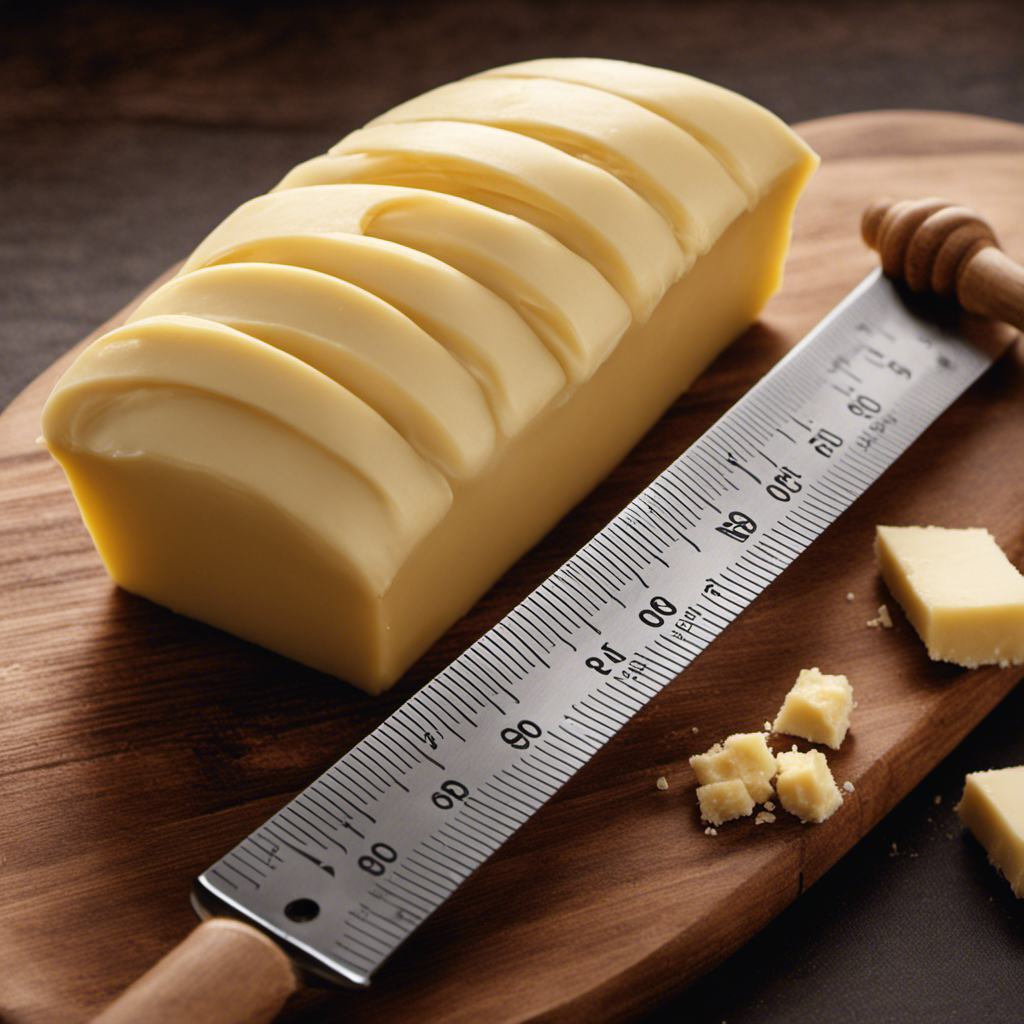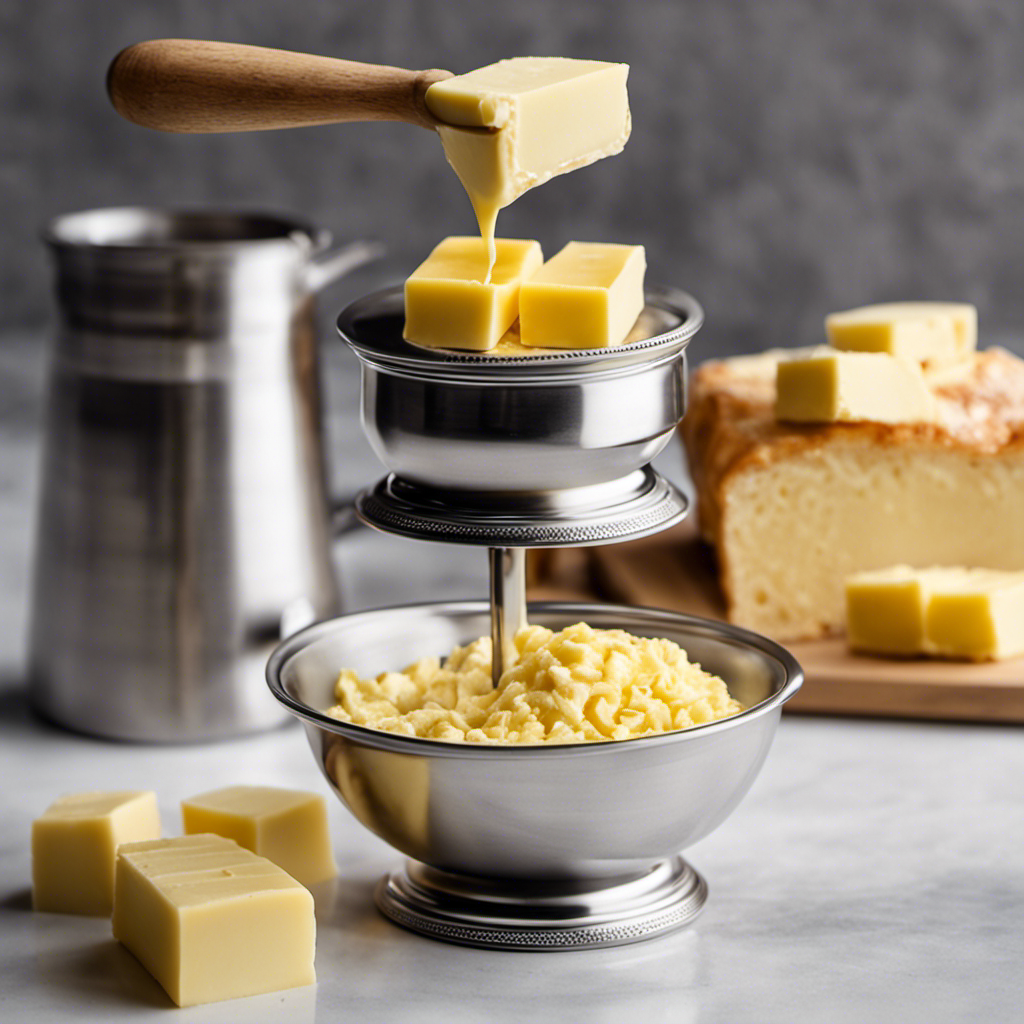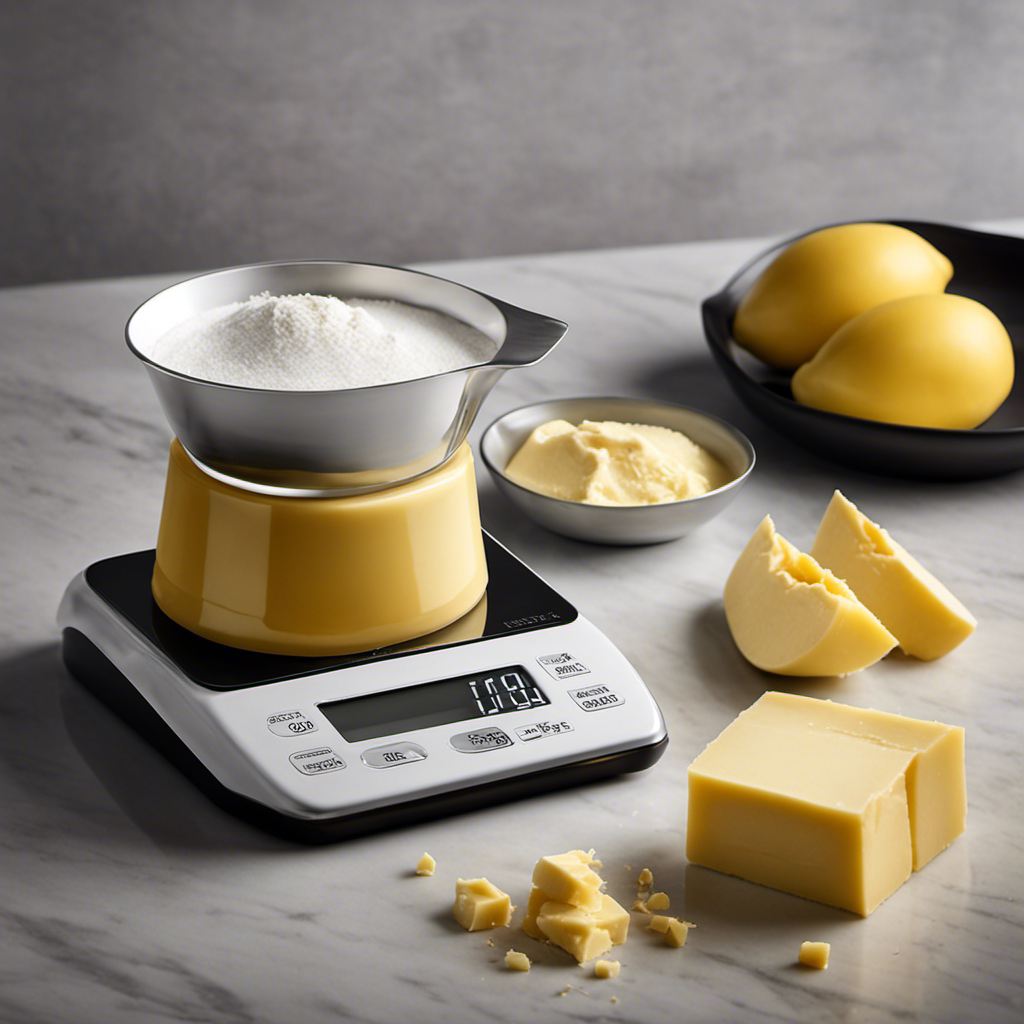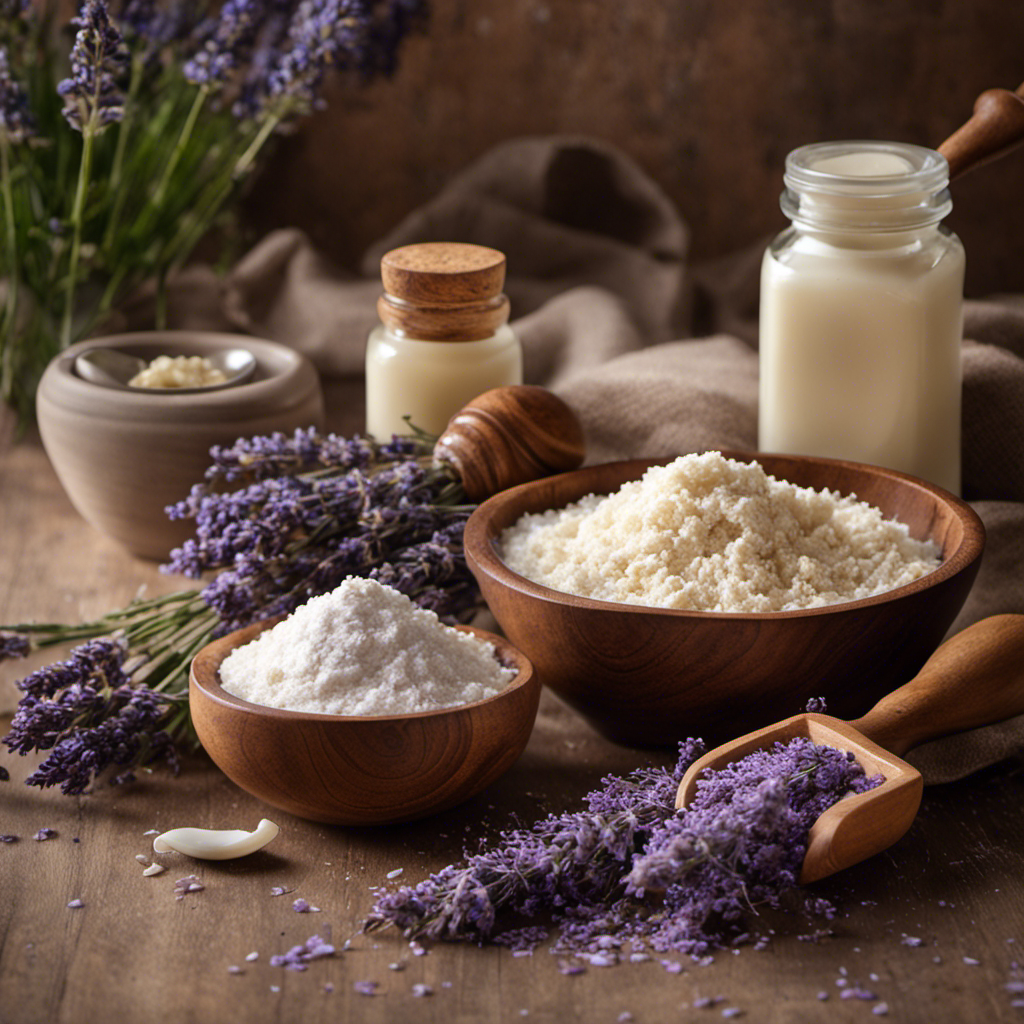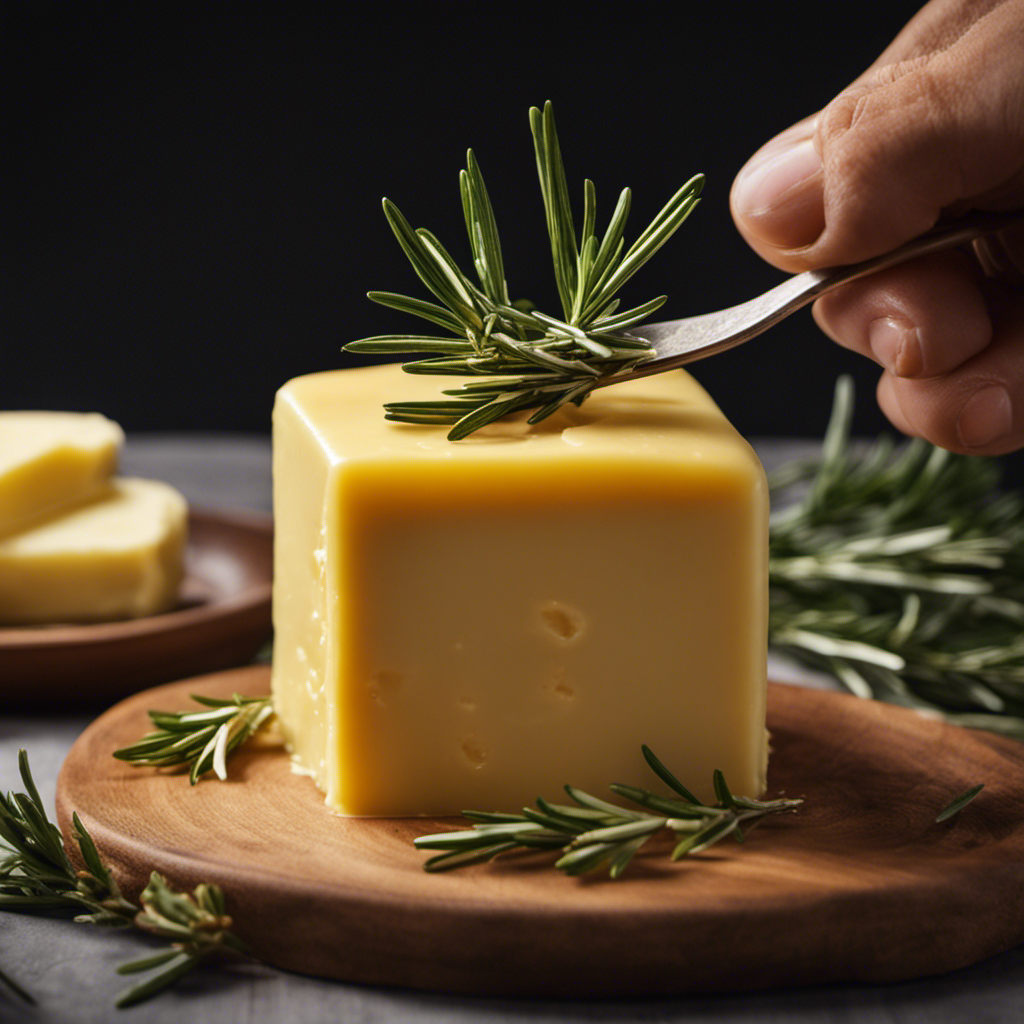Ever thought about how much 4 ounces of butter really is? Hold on tight because we’re about to dive into the world of butter!
In this article, we’ll break down the weight of butter and give you all the tips and tricks you need to bake up a storm with 4 ounces of this creamy goodness.
From converting ounces to cups, to measuring without a scale, we’ve got you covered.
So get ready to indulge in some delicious recipes that will leave you craving for more. Let’s dive in!
Key Takeaways
- 4 ounces of butter is equal to half a cup.
- Proper storage techniques are important to maintain freshness and prevent absorption of odors.
- Measuring techniques using a kitchen scale or measuring spoons are important for accurate results.
- Butter substitutes like margarine or coconut oil can be used, but they may affect the texture and taste of recipes.
Understanding the Weight of Butter
4 ounces of butter is equal to half a cup. Understanding density is important when it comes to measuring ingredients accurately in the kitchen. Density refers to how much mass a substance has in a given volume.
In the case of butter, it is crucial to know that 4 ounces is equivalent to half a cup, as this knowledge will help you follow recipes correctly. When storing butter, it is best to keep it in the refrigerator, tightly wrapped or sealed in an airtight container. This helps to maintain its freshness and prevent it from absorbing odors from other foods.
If you have extra butter, you can also freeze it for future use, either in its original packaging or portioned into smaller amounts. Remember, understanding density and proper storage techniques will ensure that your butter stays fresh and ready to use whenever you need it.
Converting Ounces to Cups: Butter Measurements
Are you tired of struggling with converting butter measurements? In this discussion, we will explore the secrets to achieving perfect butter cup conversion, ensuring your recipes turn out just right every time.
We will also delve into the importance of accurate measuring techniques to guarantee precise results.
And to top it off, we will share some common butter recipes that will have you whipping up delicious creations in no time.
Butter Cup Conversion
To convert butter cups, you’ll need to know how much is 4 ounces of butter. Understanding this measurement is crucial for accurate baking and cooking. Here are some interesting facts to grab your attention:
- Did you know that 4 ounces of butter is equal to 1/2 cup?
- Butter cups can vary depending on the region, but 4 ounces is a universal measurement.
- If you’re looking for a healthier alternative, you can use butter substitutes like margarine or coconut oil.
- Keep in mind that butter substitutes may affect the texture and taste of your recipes.
Now that you know how much 4 ounces of butter is, let’s move on to accurate measuring techniques. It’s essential to measure ingredients correctly to ensure the perfect outcome of your culinary creations. Let’s dive into the world of precise measurements and elevate your cooking skills!
Accurate Measuring Techniques
When it comes to accurate measuring techniques, it’s important to use the proper tools and follow the recipe instructions carefully. Measuring equivalents can be tricky, especially when it comes to butter substitutes.
To accurately measure butter, you need to know how many ounces are required. If a recipe calls for 4 ounces of butter, you can use a kitchen scale to measure it precisely. Simply place a bowl on the scale, set it to zero, and add the butter until it reaches 4 ounces.
If you don’t have a scale, you can use measuring spoons. One stick of butter is equivalent to 4 ounces, so you can measure out one stick or use tablespoons to reach the desired amount.
Common Butter Recipes
In many common butter recipes, it’s important to use the correct amount of butter to ensure the desired flavor and texture. Understanding butter substitutes and the nutritional value of butter can help you make informed choices when cooking.
Here are four things you need to know:
-
Butter substitutes: If you’re looking for a healthier alternative to butter, consider using substitutes like olive oil, coconut oil, or applesauce. Each has its own unique flavor and can add moisture to your recipes.
-
Nutritional value of butter: Butter is rich in saturated fat and calories. While it adds a creamy texture and delicious taste to dishes, it’s important to consume it in moderation due to its potential impact on heart health.
-
Flavor and texture: Butter adds richness and depth to recipes, enhancing both the flavor and texture of baked goods, sauces, and more. It can create a flaky crust on pastries and a velvety smoothness in sauces.
-
Melting point: Butter has a lower melting point compared to other fats, which allows it to create tender baked goods and give a silky mouthfeel to sauces. It’s important to follow recipe instructions when melting butter to achieve the desired results.
Baking With 4 Ounces of Butter: Tips and Tricks
Baking with 4 ounces of butter can enhance the flavor and moisture of your baked goods. If you’re looking to substitute butter in your recipe, there are a few options you can try.
One option is to use margarine, which has a similar texture and taste to butter. Another option is to use coconut oil, which can add a subtle tropical flavor to your baked goods.
When it comes to storing butter, it’s important to keep it in a cool, dry place. If you’re not planning to use the butter right away, you can store it in the refrigerator for up to a month. For longer storage, you can freeze butter for up to six months. Just make sure to wrap it tightly to prevent freezer burn.
4 Ounces of Butter in Grams: A Metric Conversion Guide
To convert ounces of butter to grams, you can multiply the number of ounces by 28.35. This simple conversion allows you to easily switch between the two measurements when working with butter in recipes. So, whether you’re baking a cake or cooking a savory dish, knowing how much your butter weighs in grams can be incredibly helpful.
But why does it matter? Here are four reasons why understanding butter weight and its conversion to grams is important:
- Precision: Baking is a science, and precise measurements are crucial for successful results.
- Consistency: Using the correct amount of butter ensures consistent texture and flavor in your dishes.
- International recipes: Many recipes from around the world use grams as their primary unit of measurement.
- Butter substitutes: If you’re looking to replace butter with a healthier option, knowing the weight in grams can help you find suitable alternatives.
How to Measure 4 Ounces of Butter Without a Scale
When it comes to measuring butter without a scale, you have a few alternative methods at your disposal. Whether you prefer using measuring cups, spoons, or the handy butter wrappers, there are different conversion ratios to keep in mind.
To ensure accurate measurements, it’s essential to follow some tips. First, make sure to soften the butter properly. This means allowing it to come to room temperature before measuring. Softened butter is easier to work with and will provide more accurate measurements.
Next, when measuring, always use level measurements. This means scraping off any excess butter from the top of the measuring cup or spoon, ensuring that you have the exact amount needed.
Alternative Measuring Methods
There’s an easier way to measure ingredients without using traditional measuring cups. When it comes to butter, there are different units for measuring it, and converting butter measurements can be a hassle. But fear not, because I have some alternative measuring methods that will make your life easier in the kitchen.
Check out these tips:
-
Use a tablespoon: Did you know that 1 stick of butter is equal to 8 tablespoons? That’s a handy conversion to keep in mind when you need a smaller amount of butter for your recipe.
-
Use a kitchen scale: If you have a kitchen scale, you can measure butter in grams or ounces. Simply place your bowl on the scale, zero it out, and add the desired amount of butter.
-
Use the water displacement method: Fill a liquid measuring cup with water and add the butter until the water level rises to the desired measurement. This is a great method if you don’t have a scale or measuring cups on hand.
-
Use the markings on the butter wrapper: Most butter wrappers have markings on them to indicate tablespoons or ounces. Simply cut along the markings to get the right amount of butter.
With these alternative measuring methods, you can easily measure butter without the need for traditional measuring cups. So go ahead and get creative in the kitchen!
Butter Conversion Ratios
If you’re unsure about the conversion ratios, remember that 1 stick of butter is equal to 8 tablespoons. Converting butter to tablespoons can be a bit confusing, especially if you’re used to measuring it in ounces or grams. To make it easier for you, here’s a handy table that shows the butter weight equivalents in tablespoons:
| Butter Weight | Tablespoons |
|---|---|
| 1 ounce | 2 tablespoons |
| 2 ounces | 4 tablespoons |
| 4 ounces | 8 tablespoons |
| 8 ounces | 16 tablespoons |
Now that you know the conversion ratios, you can easily measure butter in tablespoons. But if you want to ensure accuracy, there are a few tips you should keep in mind.
Tips for Accurate Measurement
To ensure accurate measurement, remember to level off the top of the tablespoon when measuring out butter equivalents. Converting butter measurements can be a bit tricky, but with the right knowledge, you’ll be able to accurately measure out the perfect amount every time. Here are some tips to help you along the way:
-
Use a kitchen scale: This is the most accurate way to measure butter, especially when dealing with larger quantities.
-
Use a measuring cup: If you don’t have a kitchen scale, you can use a measuring cup marked with tablespoons and ounces.
-
Soften the butter: If the butter is too hard to measure accurately, let it soften at room temperature until it becomes more pliable.
-
Be consistent: Stick to one method of measurement throughout your recipe to ensure consistency in the final result.
Delicious Recipes Using 4 Ounces of Butter
You can find a variety of delicious recipes that use 4 ounces of butter. In cookies, 4 ounces of butter adds richness and a velvety texture, resulting in delectable treats that melt in your mouth. From classic chocolate chip cookies to buttery shortbread, the possibilities are endless.
But don’t limit yourself to just sweets! Savory dishes also benefit from the addition of 4 ounces of butter. It adds a lusciousness and depth of flavor to dishes like creamy pasta sauces, sautéed vegetables, and flaky pie crusts.
Whether you’re whipping up a batch of cookies or preparing a savory dinner, using 4 ounces of butter will take your recipes to the next level. So go ahead and indulge in the magic of butter!
Conclusion
Congratulations! Now you’re a butter expert. You’re armed with all the knowledge you need to conquer any recipe that calls for 4 ounces of butter. Whether you’re converting measurements, baking up a storm, or even measuring without a scale, you’ve got it covered.
With these tips and tricks in your culinary arsenal, you’ll be whipping up delicious dishes in no time. So go ahead, spread your wings like a butterfly and let your culinary creativity soar!
